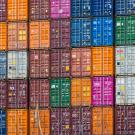
Tariffs on goods imported to the U.S. are not new, but today they are being discussed as much broader tools in a more complicated world.
Since before the Constitution was signed, tariffs have reduced the competitiveness of American enterprise and increased the cost of goods. Today, they are proposed to bring back U.S. manufacturing jobs to communities that provided the president his strongest support while also being leveraged as expansive geopolitical tools with uncertain consequences.
“I think there are broader questions of political economy surrounding tariff proposals today,” said Katheryn Russ, a professor of economics in the College of Letters and Science at UC Davis and leading expert on international economics. “You might say tariffs can resolve issues of inequality, but it’s really the net outcome of all the tax, social safety net and spending policies that determine whether this administration favors non-college educated workers.”
What is a tariff?
A tariff is a type of tax a government adds to imported goods. Companies importing goods pay the tariff to the government. If any part of a product arrived with a tariff, whether it’s an imported banana or a car built locally with imported steel, its cost is part of the price everyday consumers pay before sales tax.
“You don't see tariffs up front at the store and you don't see them on the receipt, but they're embedded in the price of the good,” said Russ, who recently co-authored a chapter on tariffs and the macroeconomy in the forthcoming Oxford Encyclopedia of International Economics (Oxford University Press).
Tariffs increase the price of some goods, but their additional cost is hidden partly because so much of what we buy today is made of parts and materials from across a global value chain. Raw materials, assembled components and even the design for a single product might be sourced from across multiple countries.
“When we put tariffs on imported goods, the costs of these tariffs are embedded in the price of what we buy in very complicated ways,” said Russ.
How do tariffs affect consumers?
Tariffs affect consumers in two main ways. First, they increase the cost of what we buy when the added cost, which companies pay as a tax to the federal government, gets passed on to consumers. Second, they might reduce the range of products available by making some importation unprofitable.
“Consumers are probably going to have to pay higher prices, and they may even have a lower range of choices at the store because some things just become too expensive to bother importing,” said Christopher Meissner, a professor of economics in the College of Letters and Science at UC Davis.
Meissner is a leading expert on international trade. His recent book, One from the Many: The Global Economy Since 1850 (Oxford University Press, 2024), details the economic history of the global economy, grounding the idea of globalization in the technologies that made it possible.
In the end, tariffs could increase the overall cost of living.
“Once you start raising the prices on imports, that's just going to raise the cost of living, and wages are going to have to respond to offset some of those higher costs,” said Meissner.
How do tariffs affect business?
One argument for tariffs is that they protect domestic companies from foreign competitors that can undercut them on prices. Alexander Hamilton, one of the founding fathers, argued that tariffs and other protections from foreign competition would make U.S. industries more productive and competitive.
Meissner’s new research shows that in the late 1800s, tariffs didn’t make U.S. businesses more productive but had the opposite effect. Meissner’s study of U.S. tariffs from 1870 to 1909 found that an increase in tariffs of 10 percentage points reduced domestic productivity by between 25% and 35%.
“Less competitive industries are less innovative, and less innovative industries are less productive,” said Meissner. “Tariffs probably weakened the incentives to innovate and come up with streamlined processes that keep companies on their toes and productivity high.”
Today, a lot of American jobs depend indirectly on manufacturing, even if that manufacturing takes place abroad. Meissner said that manufacturing is a smaller share of the U.S. Gross Domestic Product, or GDP, compared to what it has been historically. According to the St. Louis Federal Reserve, manufacturing's share of GDP dropped from 28.1% in 1953 to 12% in 2015.
“We design it, we bring it to market, and we do all the engineering here, so those jobs will also be affected by today's tariffs even though it's a more complicated complex international economy than it once was,” said Meissner.
How do tariffs affect the national economy?
Tariffs affect the national economy today much differently than they ever because of the state of the global economy. The past four decades has seen a steady increase in cheaper international imports, particularly from China, in industries where U.S. manufacturing processes became standardized and thus less tethered to areas with high concentrations of specialized, highly educated workers.
In recent research, Russ and coauthors from UC Davis and George Washington University found that this shift to lower-cost production that was increasingly outsourced from the northeastern United States to places further south and west with cheaper labor had already begun by the middle of the 20th century. Then the import surge from China around 1990 sparked a rapid economic unraveling.
“In some communities, the shock of the import surge happened so fast that it basically short circuited this more gradual product cycle that already had been going on for decades,” said Russ.
Russ said the impacts of this shift have been highly concentrated in U.S. communities that already had higher rates of unemployment and fewer college-educated workers.
“We assumed that our trade adjustment assistance and our social safety net programs would take care of all of this, but in fact it didn't, and we saw really big employment impacts concentrated in some of our most vulnerable communities,” said Russ.
At the time, tariffs seemed an ideal tool to protect domestic manufacturing from disappearing under the swell of cheaper foreign imports. Today, Russ explained, it’s not that simple. A country like China can evade tariffs by investing in manufacturing or assembly in a different country that is not subject to the same tariffs. Tariffs can quickly lead to an infinite shell game to avoid them.
At the World Economic Forum in January, the president asked countries to make products in the U.S. in exchange for a very low corporate tax rate — or their products will face tariffs to serve the U.S. market. Russ said this idea amounts to an announcement of an across-the-board tariff.
“All of our trading partners would be affected, so that's an across-the-board tariff,” said Russ. “That is something new that we didn't see in the first Trump administration. He is talking about trying to create a resurgence of different industries inside the United States by building a wall of tariffs to reduce imports.”
What are the potential consequences of Trump’s tariff plan?
Tariffs today are being discussed as more than tools to protect U.S. companies. They are mentioned as a tool for bringing back manufacturing as well as a bargaining tactic in negotiations over immigration and the flow of fentanyl.
However tariffs are used, they are likely to be met with retaliation, as China retaliated immediately with their own tariffs once the trade war began in 2018 under the first Trump administration. In February 2025, China’s government announced retaliatory tariffs and other measures that affect U.S. business.
“Once we start raising tariffs on our main trading partners as is proposed, they're certainly going to retaliate, and those retaliations will offset many of the positive effects, if there are any,” said Meissner.
Read the original version at UC Davis Magazine.
YOU MAY ALSO LIKE THESE STORIES

They Don’t Pay, We Do: How Trump Tariffs Might Reshape the U.S. Economy
New research in economics looks back at the history of U.S. tariffs and finds that from 1870 to 1909, tariffs made U.S. businesses weaker, not stronger. Tariffs reduced the average size of businesses while increasing the price of what they produced. Because tariffs work the same way they did 100 years ago, these findings have relevance today.

Avoiding the Next Infant Formula Supply Crisis
In 2022, the nation’s largest infant formula manufacturer sent new parents scrambling when it launched a product recall that sparked shortages nationwide. UC Davis researchers contributed to a National Academies of Sciences, Engineering, and Medicine report that identifies the causes of the shortages and detailed recommendations for securing national supplies.
